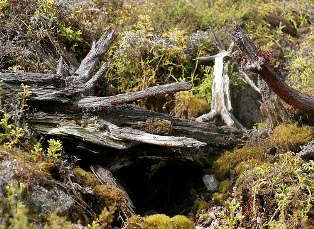Was the last common ancestor of all life not a free-living cell, but a porous rock riddled with bubbly iron-sulphur membranes that catalysed primordial biochemical reactions and that filled up with organic chemicals, giving rise to proto-life which eventually broke out as the first living cells – not once but twice, giving rise to the bacteria and the archaea? In 1978 Nobel winner Peter Mitchell proposed that energy from the sun is converted into a proton gradient in essentially the same way as the energy of food. Life, he argued, is powered not by the kind of chemistry that goes on in a test tube but by a kind of electricity. A molecule acts as a chemical 'battery', storing energy when it is not needed, but able to release it instantly when the organism requires it.
A few researchers have been rethinking the origin of life in the light of Mitchell's ideas and have come up with a radically different picture of what the earliest life was like and where it evolved. It's a picture for which there is growing geological evidence.
From the early 1990s, geochemist Mike Russell explored the possibilities of a very particular kind of hydrothermal vent called an alkaline vent, at the time known only from remnants found in ancient rocks. Interest in alkaline vents rose in 2000, when Deborah Kelley et al from the University of Washington in Seattle found an active alkaline vent field just off the mid-Atlantic ridge, exactly where Russell said such vents should be. The team dubbed it the Lost City, partly for its spectacular spires of rock, which form as carbonates precipitate out in the alkaline fluid. Like ancient vents, the spires of the Lost City are riddled with tiny pores, some with dimensions not dissimilar to modern cells. The interface between the alkaline vents and the ancient seas would have been much more conducive to primordial biochemistry than they are today. In particular, bubbles of iron-sulphur minerals – which have remarkable catalytic properties – would have formed in the pores. The alkaline vents would have had a labyrinth of naturally forming microcompartments, which would have been the scaffold within which the first cells could form. Identical iron-sulphur minerals can still be found at the heart of proteins that convert carbon dioxide to sugars – using hydrogen gas – in archaea and bacteria. Back then the seas were acidic, and therefore rich in protons. "Alkaline fluids bubbling into an acidic ocean form catalytic mineral 'cells' with a proton gradient across their inorganic membranes," says Russell. "They're set up in the same peculiar way as all cells today."
Indeed, it appears Mitchell's oddity is a necessary precondition for life. While breaking down sugars can provide enough energy for growth without any need for chemiosmosis, the process – glycolysis – involves complex pathways and requires lots of sugar, and is thus very unlikely to have been the main source of energy for the first life.
Many details have yet to be filled in, but this scenario matches the known properties of all life on Earth, is energetically plausible – and returns Mitchell's great theory to its rightful place at the very centre of biology.
Image: "Steam Vent" by Strange Ones on Flickr courtesy of Creative Commons Licensing.















